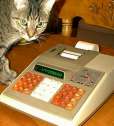Casio PD-310
| Datasheet legend
Ab/c:
Fractions calculation
AC: Alternating current BaseN: Number base calculations Card: Magnetic card storage Cmem: Continuous memory Cond: Conditional execution Const: Scientific constants Cplx: Complex number arithmetic DC: Direct current Eqlib: Equation library Exp: Exponential/log functions Fin: Financial functions Grph: Graphing capability Hyp: Hyperbolic functions Ind: Indirect addressing Intg: Numerical integration Jump: Unconditional jump (GOTO) Lbl: Program labels LCD: Liquid Crystal Display LED: Light-Emitting Diode Li-ion: Li-ion rechargeable battery Lreg: Linear regression (2-var. stats) mA: Milliamperes of current Mtrx: Matrix support NiCd: Nickel-Cadmium recharg. batt. NiMH: Nickel-metal-hydrite rech. batt. Prnt: Printer RTC: Real-time clock Sdev: Standard deviation (1-var. stats) Solv: Equation solver Subr: Subroutine call capability Symb: Symbolic computing Tape: Magnetic tape storage Trig: Trigonometric functions Units: Unit conversions VAC: Volts AC VDC: Volts DC |
| ||||||||||||||||||||||||||||||||||||||||||||||||||||||||
Casio PD-310
 The PD-310 is a rather unusual calculator. Its folding design is not one commonly used by Casio. The lack of a model number on the device itself suggests that it may, in fact, be from a small or prototype production run. It is also identical in function and appearance to the PD-300 except that the latter omits the right-side keyboard panel: hence, it is not programmable, and unless you download programs to it, it is usable only as a 4-function calculator.
The PD-310 is a rather unusual calculator. Its folding design is not one commonly used by Casio. The lack of a model number on the device itself suggests that it may, in fact, be from a small or prototype production run. It is also identical in function and appearance to the PD-300 except that the latter omits the right-side keyboard panel: hence, it is not programmable, and unless you download programs to it, it is usable only as a 4-function calculator.
Download programs? Well, yes. The PD-310 appears to be nothing less than a programming system for the PD-300. The machines are also compatible with the FP-40 personal printer which, in turn, has connectors for an external cassette recorder where programs can be saved.
But, back to the PD-310. It has an unusually large amount of memory for calculators of its kind: a whopping 16 kilobytes! The programming model is typical Casio, no surprises there. To demonstrate, here's a version of my favorite programming example, the Gamma function:
10 INPUT X 20 G=1 30 IF X>5 THEN 70 40 G=G*X 50 X=X+1 60 GOTO 30 70 G=X*LOGX-X+LOG(SQR(2*π/X)/G) 80 G=G+((((1/99/X/X-1/140)/X/X+1/105)/X/X-1/30)/X/X+1)/12/X 90 PRINT G,EXPG


